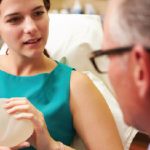Taking it all together, it seems that enigmatic but nevertheless common and often disabling complaints can coincide in many individuals diagnosed with siliconosis, MMF, GWS, or postvaccination events (see Table 1). Additionally, in up to 35% of these patients, autoimmunity (e.g., autoantibodies) or an overt autoimmune disease may eventually be diagnosed. A noteworthy common denominator is that the exposure to a component that comprises an adjuvant effect can be documented in each of those medical conditions. These phenomena can occur weeks and even or years following exposure to a culprit agent. Moreover, genetic links observed in animal models, and in the human disease MMF, bring about the notion that the adjuvant effect promotes the appearance of an adjuvant disease in subjects who are genetically susceptible or in those who encounter an additional trigger, such as the effect of another deleterious environmental factor (e.g., infectious agent) or co-exposure to more than one adjuvant.
Last but not least, these medical conditions were recently encompassed as ASIA. Looking back at the numerous reports in the last four or even five decades, one might ask if this is actually a new syndrome. Apparently, physicians have observed these phenomena for years, but the lack of definition remained a major obstacle in diagnosing, treating, and conducting basic as well as clinical studies.
Perhaps the most novel aspect of this new syndrome is its spacious view of these comparable diseases as well as improvement of their definition and diagnosis utilizing major and minor criteria (see Table 2). This innovative characterization may provide physicians a better way to understand to the immune consequences of environmental adjuvants and advance the diagnosis of patients suffering from the adjuvant diseases. Moreover, unraveling the adjuvant diseases pathogenesis may facilitate the search for preventive and therapeutic interventions such as immune modulation of the adjuvant pathways (e.g., TLRs , inflammasome, and others).
Dr. Shoenfeld is head of the Zabludowicz Center for Autoimmune Diseases, Sheba Medical Center (affiliated with Tel-Aviv University), Tel-Hashomer, Israel. Dr. Levine is a senior physician in the Zabludowicz Center.
References
- Agmon-Levin N, Shoenfeld Y. Chronic fatigue syndrome with autoantibodies—the result of an augmented adjuvant effect of hepatitis-B vaccine and silicone implant. Autoimmun Rev. 2008;8:52-55.
- Hajdu SD, Agmon-Levin N, Shoenfeld Y. Silicone and autoimmunity. Eur J Clin Invest. 2011;41:203-211.
- Agmon-Levin N, Paz Z, Israeli E, Shoenfeld Y. Vaccines and autoimmunity. Nat Rev Rheumatol. 2009;5:648-652.
- Hotopf M, David A, Hull L, Ismail K, Unwin C, Wessely S. Role of vaccinations as risk factors for ill health in veterans of the Gulf War: Cross sectional study. BMJ. 2000;320:1363-1367.
- Israeli E, Agmon-Levin N, Blank M, Shoenfeld Y. Macrophagic myofaciitis a vaccine (alum) autoimmune-related disease. Clin Rev Allergy Immunol. 2010 Sep 30. [Epub ahead of print]
- Shoenfeld Y, Agmon-Levin N. ‘ASIA’- autoimmune/auto inflammatory syndrome induced by adjuvant. J Autoimmun. 2011;36(1):4-8.
- Shapira Y, Agmon-Levin N, Shoenfeld Y. Defining and analyzing geoepidemiology and human autoimmunity. J Autoimmun. 2010;34:J168-J177.
- Shoenfeld Y, Zandman-Goddard G, et al. The mosaic of autoimmunity: Hormonal and environmental factors involved in autoimmune diseases—2008. Isr Med Assoc J. 2008;10:8-12.
- Kivity S, Agmon-Levin N, Blank M, Shoenfeld Y. Infections and autoimmunity. Trends Immunol. 2009;30:409-414.
- Israeli E, Agmon-Levin N, Blank M, Shoenfeld Y. Adjuvants and autoimmunity. Lupus. 2009;18:1217-1225.
- Marrack P, McKee AS, Munks MW. Towards an understanding of the adjuvant action of aluminium. Nat Rev Immunol. 2009;9:287-293.
- Kool M, Soullié T, van Nimwegen M, et al. Alum adjuvant boosts adaptive immunity by inducing uric acid and activating inflammatory dendritic cells. J Exp Med. 2008;14;205:869-882.
- Reeves WH, Lee PY, Weinstein JS, Satoh M, Lu L. Induction of autoimmunity by pristane and other naturally occurring hydrocarbons. Trends Immunol. 2009;30:455-464.
- Santoro D, Stella M, Montalto G, Castelli S. Lupus nephritis after hepatitis B vaccination: An uncommon complication. Clin Nephrol. 2007;67:61-63.
- Lerner A. Aluminum is a potential environmental factor for Crohn’s disease induction: Extended hypothesis. Ann NY Acad Sci. 2007;1107:329-345.
- Shaw CA, Petrik MS. Aluminum hydroxide injections lead to motor deficits and motor neuron degeneration. J Inorg Biochem. 2009;103:1555-1562.
- Hornung V, Bauernfeind F, Halle A, et al. Silica crystals and aluminum salts activate the NALP3 inflammasome through phagosomal destabilization. Nat Immunol. 2008;9:847-856.
- Rose NR. Autoimmunity, infection and adjuvants. Lupus. 2010;19:354-358.
- Hennekens CH, Lee IM, Cook NR, et al. Self-reported breast implants and connective-tissue diseases in female health professionals. A retrospective cohort study. JAMA. 1996;275:616-621.
- Janowsky EC, Kupper LL, Hulka BS. Meta-analyses of the relation between silicone breast implants and the risk of connective-tissue diseases. N Engl J Med. 2000; 342:781-790.
- Vasey FB, Zarabadi SA, Seleznick M, Ricca L. Where there’s smoke there’s fire: The silicone breast implant controversy continues to flicker: A new disease that needs to be defined. J Rheumatol. 2003;30: 2092-2094.
- Lasky T, Terracciano GJ, Magder L, et al. The Guillain-Barre syndrome and the 1992-1993 and 1993-1994 influenza vaccines. N Engl J Med.1998;339:1797-1802.
- Guis S, Pellissier JF, Nicoli F, et al. HLA-DRB1*01 and macrophagic myofasciitis. Arthritis Rheum. 2002; 46:2535-2537.
